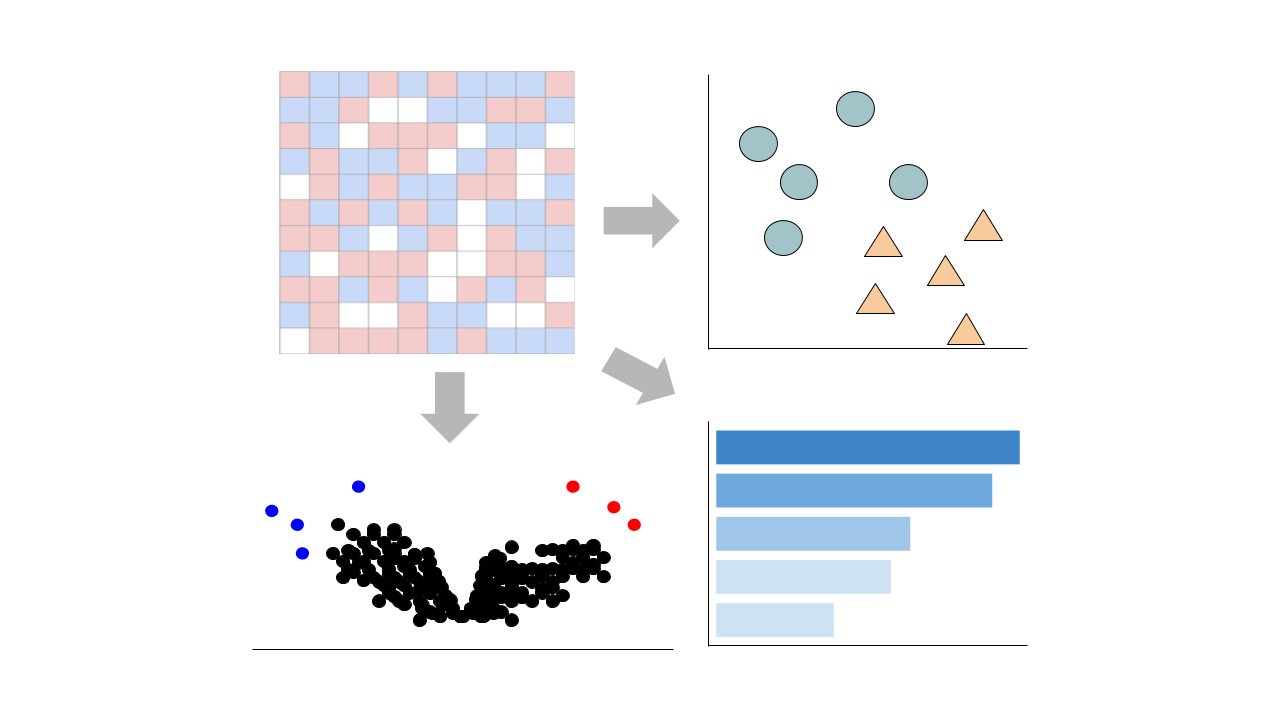 Gene counts are sourced from ARCHS4, which provides uniform alignment of GEO samples.
You can learn more about ARCHS4 and its pipeline here.
Gene counts are sourced from ARCHS4, which provides uniform alignment of GEO samples.
You can learn more about ARCHS4 and its pipeline here.
Select conditions below to toggle them from the plot:
| GROUP | CONDITION | SAMPLES |
|---|---|---|
| EndoC-𝛽H1 cells |
GSM5242720 GSM5242726 GSM5242732
|
|
|
GSM5242718 GSM5242724 GSM5242730
|
||
|
GSM5242717 GSM5242723 GSM5242729
|
||
|
GSM5242721 GSM5242727 GSM5242733
|
||
|
GSM5242719 GSM5242725 GSM5242731
|
||
|
GSM5242716 GSM5242722 GSM5242728
|
Submission Date: Apr 15, 2021
Summary: Type 1 diabetes (T1D) results from autoimmune destruction of β-cells in the pancreas. Protein tyrosine phosphatases (PTPs) are candidate genes for T1D and play a key role in autoimmune disease development and β-cell function. Here, we assessed the global protein and individual PTP profile in the pancreas from diabetic NOD mice treated with anti-CD3 monoclonal antibody and IL-1 receptor antagonist (IL-1RA). The treatment reversed hyperglycemia compared to the anti-CD3 alone control group. We observed enhanced expression of PTPN2, a T1D candidate gene, and endoplasmic reticulum (ER) chaperones in islets from mice with reversed diabetes. To address the functional role of PTPN2 in β-cells, we generated PTPN2 deficient stem cell-derived β-like and human EndoC-βH1 cells. Mechanistically, we demonstrated that PTPN2 inactivation in β-cells exacerbates the type I and type II IFN signalling networks, and the potential progression towards autoimmunity. Moreover, we established the capacity of PTPN2 to modulate the Ca2+-dependent unfolded protein response in β-cells. Adenovirus-induced overexpression of PTPN2 decreased BiP expression and partially protected from ER-stress induced β-cell death. Our results postulate PTPN2 as a key protective factor in β-cells during inflammation and ER stress in autoimmune diabetes.
GEO Accession ID: GSE172148
PMID: 35044456
Submission Date: Apr 15, 2021
Summary: Type 1 diabetes (T1D) results from autoimmune destruction of β-cells in the pancreas. Protein tyrosine phosphatases (PTPs) are candidate genes for T1D and play a key role in autoimmune disease development and β-cell function. Here, we assessed the global protein and individual PTP profile in the pancreas from diabetic NOD mice treated with anti-CD3 monoclonal antibody and IL-1 receptor antagonist (IL-1RA). The treatment reversed hyperglycemia compared to the anti-CD3 alone control group. We observed enhanced expression of PTPN2, a T1D candidate gene, and endoplasmic reticulum (ER) chaperones in islets from mice with reversed diabetes. To address the functional role of PTPN2 in β-cells, we generated PTPN2 deficient stem cell-derived β-like and human EndoC-βH1 cells. Mechanistically, we demonstrated that PTPN2 inactivation in β-cells exacerbates the type I and type II IFN signalling networks, and the potential progression towards autoimmunity. Moreover, we established the capacity of PTPN2 to modulate the Ca2+-dependent unfolded protein response in β-cells. Adenovirus-induced overexpression of PTPN2 decreased BiP expression and partially protected from ER-stress induced β-cell death. Our results postulate PTPN2 as a key protective factor in β-cells during inflammation and ER stress in autoimmune diabetes.
GEO Accession ID: GSE172148
PMID: 35044456
Visualize Samples
 Visualizations are precomputed using the Python package scanpy on the top 5000 most variable genes.
Visualizations are precomputed using the Python package scanpy on the top 5000 most variable genes.
Precomputed Differential Gene Expression
 Differential expression signatures are automatically computed using the limma R package.
More options for differential expression are available to compute below.
Differential expression signatures are automatically computed using the limma R package.
More options for differential expression are available to compute below.
Signatures:
Select conditions:
Control Condition
Perturbation Condition
Only conditions with at least 1 replicate are available to select
 Differential expression signatures can be computed using DESeq2 or characteristic direction.
Differential expression signatures can be computed using DESeq2 or characteristic direction.
This pipeline enables you to analyze and visualize your bulk RNA sequencing datasets with an array of downstream analysis and visualization tools. The pipeline includes: PCA analysis, Clustergrammer interactive heatmap, library size analysis, differential gene expression analysis, enrichment analysis, and L1000 small molecule search.

 Chatbot
Chatbot Single Gene Queries
Single Gene Queries
 Gene Set Queries
Gene Set Queries
 Bulk Studies
Bulk Studies
 Single Cell Studies
Single Cell Studies
 Hypotheses
Hypotheses
 Resources
Resources
 Contribute
Contribute
 Downloads
Downloads About
About
 Help
Help